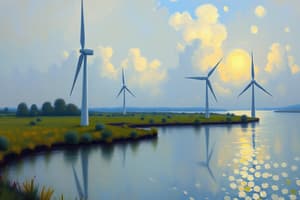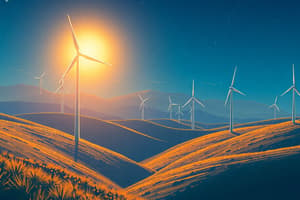Podcast
Questions and Answers
What primary function do wind turbines serve in wind energy generation?
What primary function do wind turbines serve in wind energy generation?
- Filtering atmospheric pollutants
- Converting wind kinetic energy into mechanical power or electricity (correct)
- Generating thermal energy from sunlight
- Converting mechanical power to hydraulic energy
Which type of wind turbine is mounted with blades that are oriented vertically?
Which type of wind turbine is mounted with blades that are oriented vertically?
- Multi-Directional Wind Turbine
- Vertical Axis Wind Turbine (VAWT) (correct)
- Horizontal Axis Wind Turbine (HAWT)
- Hybrid Wind Turbine
What is a notable advantage of wind energy?
What is a notable advantage of wind energy?
- High dependence on fossil fuels
- Constant energy output regardless of wind speed
- Requires high operational costs
- Reduction of greenhouse gas emissions (correct)
What is a significant disadvantage associated with wind energy?
What is a significant disadvantage associated with wind energy?
Which of the following statements about the global status of wind energy is true?
Which of the following statements about the global status of wind energy is true?
What does the capacity factor of a wind turbine measure?
What does the capacity factor of a wind turbine measure?
What future trend in wind energy involves developing wind farms in deeper waters?
What future trend in wind energy involves developing wind farms in deeper waters?
How does wind energy impact land use, particularly in relation to agriculture?
How does wind energy impact land use, particularly in relation to agriculture?
Flashcards are hidden until you start studying
Study Notes
Wind Energy
-
Definition: Wind energy is the process of converting wind kinetic energy into mechanical power or electricity using wind turbines.
-
Types of Wind Turbines:
- Horizontal Axis Wind Turbines (HAWT): Most common; features two or three blades mounted on a tower.
- Vertical Axis Wind Turbines (VAWT): Blades are vertical; less common but can capture wind from any direction.
-
How It Works:
- Wind turns the blades of the turbine.
- The rotation drives a generator to produce electricity.
- Turbines are typically installed in wind farms, both onshore and offshore.
-
Advantages:
- Renewable and sustainable energy source.
- Reduces greenhouse gas emissions.
- Low operational costs after installation.
- Creates jobs in manufacturing, installation, and maintenance.
-
Disadvantages:
- Intermittent energy source (depends on wind availability).
- Potential impact on wildlife (e.g., birds and bats).
- Noise pollution from turbine operation.
- Visual impact on landscapes.
-
Global Status:
- Rapid growth in capacity and technology; major contributors include the US, China, and Germany.
- Offshore wind energy is gaining traction due to higher and more consistent wind speeds.
-
Future Trends:
- Increased efficiency and capacity of wind turbines.
- Development of floating wind farms for deeper waters.
- Integration with energy storage solutions to stabilize supply.
-
Key Terms:
- Capacity Factor: Ratio of actual output over a period to its potential output.
- Wind Resource Assessment: Evaluation of wind availability at a site for turbine placement.
- Feed-in Tariffs: Payments to energy producers for renewable energy generated.
-
Environmental Impact:
- Lower carbon footprint compared to fossil fuels.
- Land use considerations; can coexist with agriculture (agrivoltaics).
-
Policy and Incentives:
- Governments often provide subsidies, tax incentives, and renewable energy certificates to promote wind energy development.
Wind Energy Overview
- Wind energy transforms kinetic energy from wind into mechanical power or electricity using wind turbines.
Types of Wind Turbines
- Horizontal Axis Wind Turbines (HAWT): The most prevalent design, typically consisting of two or three blades mounted on a tall tower.
- Vertical Axis Wind Turbines (VAWT): Less common, designed with vertical blades; capable of capturing wind from any direction.
Operation Mechanism
- Wind flow turns the turbine blades, causing rotation that drives a generator to create electricity.
- Wind turbines are primarily installed in clusters known as wind farms, which can be located on land (onshore) or in bodies of water (offshore).
Advantages of Wind Energy
- Renewable and sustainable, providing a continuing energy supply without depleting resources.
- Contributes to reduced greenhouse gas emissions, aiding in climate change mitigation.
- Low operational costs after initial installation; maintenance is generally less expensive than fossil fuel systems.
- Job creation in sectors such as manufacturing, installation, and maintenance.
Disadvantages of Wind Energy
- Energy generation can be intermittent and highly dependent on wind conditions.
- Potential environmental concerns include impacts on wildlife, notably bird and bat mortality.
- Operational noise from turbines can be disruptive to nearby residents.
- Visual impacts may lead to public opposition due to changes in landscape aesthetics.
Global Status
- Significant expansion in wind energy capacity and advancements in technology, predominantly in regions like the USA, China, and Germany.
- Offshore wind energy is experiencing growth due to access to higher and more consistent wind speeds compared to onshore alternatives.
Future Trends
- Aiming for increased turbine efficiency and capacity, maximizing energy output.
- Exploration and development of floating wind farms that enable energy capture in deeper waters.
- Efforts for integrating energy storage solutions to ensure a stable and reliable energy supply.
Key Terms
- Capacity Factor: Indicates the ratio of actual energy output over time compared to the maximum potential output.
- Wind Resource Assessment: A critical evaluation process that determines wind availability at specific locations for optimal turbine placement.
- Feed-in Tariffs: Financial incentives for energy producers who generate renewable energy, ensuring stable earnings.
Environmental Impact
- Wind energy offers a smaller carbon footprint in comparison to fossil fuel-based systems.
- Land use can be efficiently managed; wind turbines can coexist with agricultural practices, leading to agrivoltaics.
Policy and Incentives
- Governments enhance wind energy development through subsidies, tax incentives, and renewable energy certificates, encouraging investment and implementation.
Studying That Suits You
Use AI to generate personalized quizzes and flashcards to suit your learning preferences.




